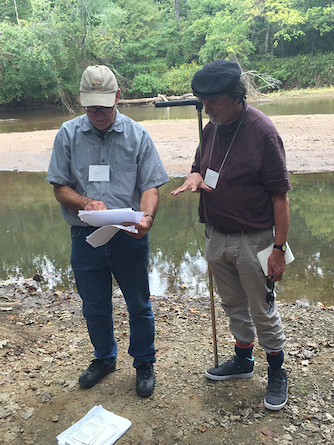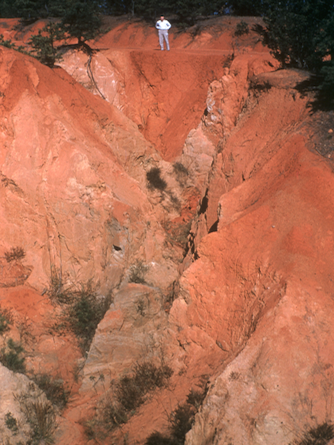* Originally posted at the Franklin Humanities Institute website (http://fhi.duke.edu/)
 Here at the FHI, particularly since the launch of our Mellon Humanities Futures initiative, we’ve been thinking a lot about new forms and trajectories of humanities research, scholarship, and education. We have to admit, though, that the idea of a road trip as mobile interdisciplinary seminar was beyond even our most creative brainstorming – until we were approached by Dan Richter, Professor of Soils and Forest Ecology at Duke’s Nicholas School of the Environment, about just such a possibility. With pre-eminent philosopher and anthropologist of science Bruno Latour as the honored guest/passenger. (!!!)
Here at the FHI, particularly since the launch of our Mellon Humanities Futures initiative, we’ve been thinking a lot about new forms and trajectories of humanities research, scholarship, and education. We have to admit, though, that the idea of a road trip as mobile interdisciplinary seminar was beyond even our most creative brainstorming – until we were approached by Dan Richter, Professor of Soils and Forest Ecology at Duke’s Nicholas School of the Environment, about just such a possibility. With pre-eminent philosopher and anthropologist of science Bruno Latour as the honored guest/passenger. (!!!)
As we write this, Richter and Latour (pictured here) are on a 2-day visit to the Calhoun Critical Zone environmental observatory in South Carolina, along with a motley crew of humanists, scientists, and artists that includes the FHI’s own documentary filmmaker Eric Barstow, Renaissance scholar/Duke Campus Farm director Saskia Cornes, environmental anthropologist Christine Folch (also Co-Director of the Global Brazil Lab), physician/medical anthropologist/Latour scholar Barry F. Saunders, geochemist Matt Ross, and artist Jenny Stratton (both Jenny and Eric are graduates of Duke’s MFA in Experimental and Documentary Arts). If you’re intrigued by the conversations among this dynamic group and the scientists at Calhoun, keep your eyes peeled for documentary films of the trip, brought to you soon by the intrepid Eric Barstow.
—
 The Calhoun Critical Zone, Richter’s research site since the 70s, is indelibly marked – eroded, gullied – by slavery, share-cropping, and clear-cutting (as this archival photo shows). But what is a Critical Zone (CZO), you ask? Here’s the definition from the NSF: “Earth’s permeable near-surface layer… from the tops of the trees to the bottom of the groundwater. It is a living, breathing, constantly evolving boundary layer where rock, soil, water, air, and living organisms interact. These complex interactions regulate the natural habitat and determine the availability of life-sustaining resources, including our food production and water quality.” In conversation with geo-scientists such as Richter, Latour expands this definition to take account of the complex, multi-layered dispersal of human actions on the earth’s surface. In an address at the 2014 Geochemistry of the Earth’s Surface Symposium, Latour notes:
The Calhoun Critical Zone, Richter’s research site since the 70s, is indelibly marked – eroded, gullied – by slavery, share-cropping, and clear-cutting (as this archival photo shows). But what is a Critical Zone (CZO), you ask? Here’s the definition from the NSF: “Earth’s permeable near-surface layer… from the tops of the trees to the bottom of the groundwater. It is a living, breathing, constantly evolving boundary layer where rock, soil, water, air, and living organisms interact. These complex interactions regulate the natural habitat and determine the availability of life-sustaining resources, including our food production and water quality.” In conversation with geo-scientists such as Richter, Latour expands this definition to take account of the complex, multi-layered dispersal of human actions on the earth’s surface. In an address at the 2014 Geochemistry of the Earth’s Surface Symposium, Latour notes:
I take "critical zone" to mean a spot on the envelope of the biosphere… which extends vertically from the top of the lower atmosphere down to the so-called sterile rocks and horizontally wherever it is possible to obtain reliable data on the various fluxes of ingredients flowing through the chosen site (which in practice generally means water catchments). "Ingredients" here does not mean only chemicals or physical elements since "EU legislation", "agricultural practices" or "land tenure" might be part of the data to recover from the study just as well as the amount of nitrates.”
—
Christine Folch kindly sent us the snapshots of Richter and Latour above and the group shot below. Tomorrow September 23, upon the group’s return from the Calhoun, the FHI will host “The Education of Bruno Latour,” a conversation centered on what he has learned (and perhaps what other humanists and social scientists might learn) from the geo-science of CZOs. The event is jointly sponsored by the FHI/Humanities Futures, the Calhoun CZO, the Nicholas School, the Duke Campus Farm, and the new Environmental Arts and Humanities Initiative at Duke. The event is completely booked – for anyone unable to join us, please note that it will be recorded and posted to the soon-to-launch Humanities Futures website. Same goes for the documentaries of the road trip/mobile seminar. Stay tuned – or keep your ears to the ground?







